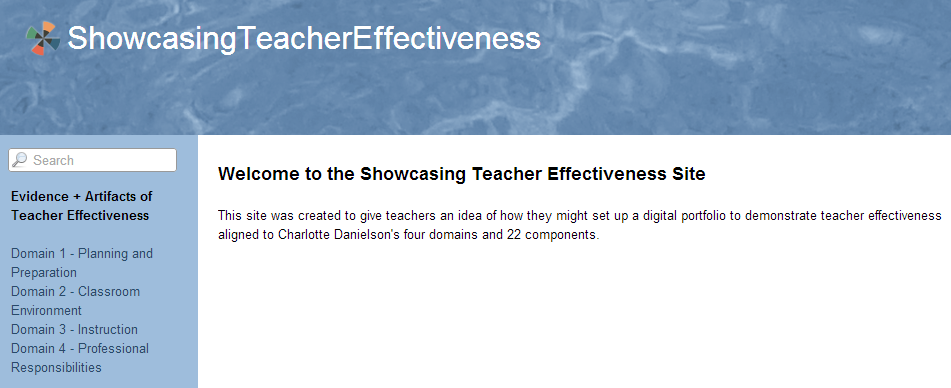How to showcase #TeacherEffectiveness using digital portfolios

Districts across the nation are asking teachers to provide artifacts and evidence of effectiveness aligned to the four domains of the Charlotte Danielson framework. (You can download the full evaluation instrument here.) This model provides an incredible opportunity to do something that is rare in the teaching profession. It provides an opportunity for teachers to release the great work they are doing from the classroom and share it with the world. It also provides a common language and method for looking at and sharing the work we do. Innovative educators take great pride in their work and they are determining ways to showcase this work using digital portfolios. Some are creating websites, others blogs or wikis, and some are using resources such as eduClipper. These digital portfolios enable educators to share their work, not only with the administrators evaluating them, but also with parents, students, peers, and anyone else who might be interested in what goes on in schools everyday.
Here are the five steps you'll need to get started.Step 1: Determine what will you use to capture effectiveness
The first step in showcasing your work is determining how it will be captured. Once you do, go forth and create your blog, wiki, website, eduClipboard, or other space that you've selected.
Step 2: Organize your space
Next you need to organize your space for success so that as you are engaging in effective practices, you have a place to put them.
This is what it might look like if you create a wiki:

Notice that in the left hand navigation, there are links to each domain.
Similarly, with eduClipper, you will want to have four eduClipboards created so that you can capture your work on the corresponding board. On each board, you can capture work that aligns to the corresponding component.

Step 3: Start collecting!
Now the fun begins. Teachers can start showcasing their effectiveness within each domain. Start by thinking of what you already do. Do you have a blog to reflect on teaching practice? Do you engage in education chats on Twitter? Do you have a Facebook page that allows you to connect and communicate with parents? These are all artifacts you could use aligned to various components of domain 4. Share that work indicating the appropriate domain and component.
Tools and ideas to transform education. Sign up below.
This is what it would look like using a wiki:
Within each domain, you'll create a page for each component.

When you have an artifact to showcase, place it on that page and explain how it is an indicator of effectiveness in the component to which it is aligned.

If you are using a tool like eduClipper it would look like the eduClipboard below which features artifacts aligned to the components of domain 4.

This is what your eduClipped artifact would look like.

Step 4: Show off
Teachers rarely have an opportunity to show off their great work. This model provides a beautiful framework in which to do so. Once you've collected your artifacts and evidence, don't be shy. It's time to show off your work to the parents of your students, colleagues, and peers around the world.
Step 5: Reflect and discuss
Each of these platforms contain social networking tools that provide a means for commenting and discussion allowing for an ongoing conversation. Once you share what you are doing, you can have a global conversation with others about your work. What might others learn from you? What suggestions may they have? How can you collaborate and grow? Once you share your work, these are some of the ways you can reflect upon and discuss what you are doing.
What do you think?
Is a digital portfolio something you might try to use to capture your practice? What other tools might you use? Do you see the advantages of a digital portfolio over other ways of sharing artifacts and evidence?
Lisa Nielsen writes for and speaks to audiences across the globe about learning innovatively and is frequently covered by local and national media for her views on “Passion (not data) Driven Learning,” "Thinking Outside the Ban" to harness the power of technology for learning, and using the power of social media to provide a voice to educators and students. Ms. Nielsen has worked for more than a decade in various capacities to support learning in real and innovative ways that will prepare students for success. In addition to her award-winning blog, The Innovative Educator, Ms. Nielsen’s writing is featured in places such as Huffington Post, Tech & Learning, ISTE Connects, ASCD Wholechild, MindShift, Leading & Learning, The Unplugged Mom, and is the author the book Teaching Generation Text.
Disclaimer: The information shared here is strictly that of the author and does not reflect the opinions or endorsement of her employer.
Lisa Nielsen (@InnovativeEdu) has worked as a public-school educator and administrator since 1997. She is a prolific writer best known for her award-winning blog, The Innovative Educator. Nielsen is the author of several books and her writing has been featured in media outlets such as The New York Times, The Wall Street Journal, and Tech & Learning.
Disclaimer: The information shared here is strictly that of the author and does not reflect the opinions or endorsement of her employer.
